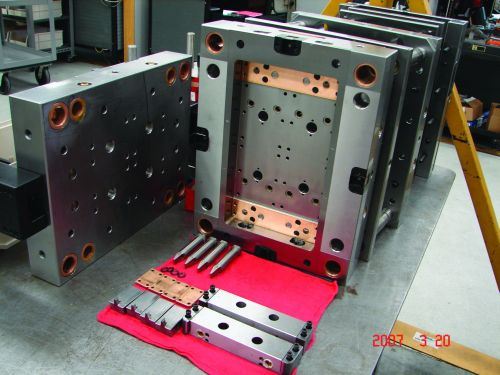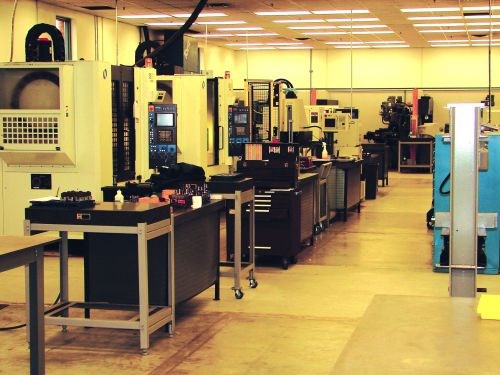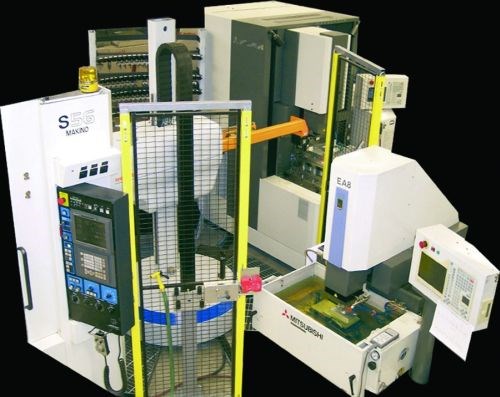Integrating Design, Manufacturing Processes
Lack of associativity between this shop’s design and manufacturing software packages led to extra work and a high risk of introducing errors into the process. To address these challenges, the mold manufacturer implemented an end-to-end CAD/CAM package from Cimatron that ensured a seamless workflow and eliminated time-consuming manual operations.
Share






Hwacheon Machinery America, Inc.
Featured Content
View More


Takumi USA
Featured Content
View More
Autodesk, Inc.
Featured Content
View More
.png;maxWidth=45)
DMG MORI - Cincinnati
Featured Content
View MoreUsing separate software packages for design and manufacturing can cause problems for shops. Data is often lost in translation, causing extra work for programmers that can impede the entire workflow. Omega Plastics, a provider of tooling and injection molding solutions for prototype and low-volume production applications, is all too familiar with these issues. To increase efficiency, the shop switched to Cimatron, an end-to-end CAD/CAM solution that streamlined operations, standardized design and manufacturing processes, saved valuable time and enabled higher product consistency.
Established in 1984, Omega operates a mold manufacturing process aided by extensive automation. Over the past 4 years, it has invested more than $2 million in tooling equipment and technology at its Clinton Township, Michigan facility. Automated cells and production control systems enable a significant portion of production to run in unattended, "lights-out" operation. The company prides itself on its efficiency, speed and quality—and did so even before switching to Cimatron for its programming needs.
Still, to remain competitive, Omega constantly seeks to improve product quality and delivery time. Thus, management is always on the lookout for ways to remove process bottlenecks and inefficiencies. "Continuous improvement is part of our culture," explains company President Jeff Kaczperski. "Getting our customers into production quicker and better than ever before is our mission."
After analyzing its processes, the company realized that using separate software packages for design and manufacturing significantly slowed production. Programmers had to continually move data from one application to the other, and thanks to lack of associativity, some part properties were lost in translation and had to be reapplied manually. The result was not only extra work, but also a higher risk of introducing errors into the process.
For example, when a customer issued an engineering change order, Omega would have to follow the tool design changes with manual updates of the cutter paths. These manual steps resulted in wasted time and resources, a problem that was exacerbated by ever-more-frequent change orders.
The shop turned to Cimatron to support the mold manufacturing process with an integrated solution from design through production. During the evaluation process, Cimatron demonstrated significant time savings—the new software enabled 20-percent faster tool design than the shop’s previous application. This could amount to two or three days on a typical tool design. "With the average tool build being three to four weeks, those two or three days became very critical to our ability to deliver on time while making high-quality products," says Chris Buch, Omega’s director of sales.
Cimatron has enabled Omega to automate key processes and create more consistency. The software complements the knowledge and experience of the shop’s employees so that they have the automation they need, yet it also allows employees to maintain control over areas that require their expertise. The software’s complete associativity helps the company eliminate time-consuming file conversions and ensures that no data is lost in translation, enabling higher quality tools at lower costs and shorter cycle times.
Additionally, the shop says it can now generate better cutter paths, resulting in less hand polishing, shorter production runs and cleaner parts. "We have always had a high level of craftsmanship, but now we have less handwork and more automation," says Mike Pavlica, vice president of operations. "This generates a greater level of consistency for the customer."
When engineering changes come along, programmers can take the file from the customer, incorporate the changes into the design, and automatically update the changes into the cutter path. The new and streamlined process removes many steps that were previously necessary, saving a great deal of time and reducing the risk of errors.
By providing an automated default output of the electrode burn line for the shop’s EDM tooling operations, Cimatron has also helped the company eliminate many hours of labor. For even greater time savings in electrode production, Cimatron is currently working with Omega on automating the EDM setup process so that the code can be written directly to the EDM machines.
Omega is also moving toward utilizing Cimatron’s templates to implement the next level of automation and standardization. While some unique characteristics of each mold still require specialization, the shop hopes to reach the point where 60 or 70 percent of the work can be standardized and automated. This would allow employees to focus
their time on higher value-added tasks for
customers.
"We always look to improve our processes and become more consistent so that our customers know we can deliver the same high-quality part regardless of who worked on it. Cimatron helps us do that," Kaczperski says.
Related Content
5 Tips for Running a Profitable Aerospace Shop
Aerospace machining is a demanding and competitive sector of manufacturing, but this shop demonstrates five ways to find aerospace success.
Read MoreContinuous Improvement and New Functionality Are the Name of the Game
Mastercam 2025 incorporates big advancements and small — all based on customer feedback and the company’s commitment to keeping its signature product best in class.
Read More6 Machine Shop Essentials to Stay Competitive
If you want to streamline production and be competitive in the industry, you will need far more than a standard three-axis CNC mill or two-axis CNC lathe and a few measuring tools.
Read MoreCutting Part Programming Times Through AI
CAM Assist cuts repetition from part programming — early users say it cuts tribal knowledge and could be a useful tool for training new programmers.
Read MoreRead Next
5 Rules of Thumb for Buying CNC Machine Tools
Use these tips to carefully plan your machine tool purchases and to avoid regretting your decision later.
Read MoreBuilding Out a Foundation for Student Machinists
Autodesk and Haas have teamed up to produce an introductory course for students that covers the basics of CAD, CAM and CNC while providing them with a portfolio part.
Read MoreRegistration Now Open for the Precision Machining Technology Show (PMTS) 2025
The precision machining industry’s premier event returns to Cleveland, OH, April 1-3.
Read More
























.png;maxWidth=150)














.jpg;maxWidth=300;quality=90)







